![]()
![]()
![]()
Use LEFT and RIGHT arrow keys to navigate between flashcards;
Use UP and DOWN arrow keys to flip the card;
H to show hint;
A reads text to speech;
97 Cards in this Set
- Front
- Back
|
Characteristics of bacteria |
Genetic material or DNA is a single circular chromosome (NOT single-stranded) Not enclosed in a membrane. Lack other membrane-bound organelles. DNA not associated with proteins known as histones( which are present in eukaryotic cells) Cell wall is always composed of peptidoglycan. ÷ by Binary fission into two identical daughter cells each with one copy of the chromosome. |
|
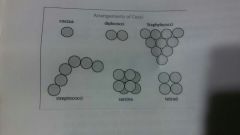
|
Arrangements of cocci |
|

|
Arrangements of bacilli |
|

Pleomorphism |
Corynebacterium pseudodiphtheriticum Non endospore forming bacillus Pleomorphic forming rods, clubs, tennis racquets, "Cheerios" |
|
|
External structures of prokaryotic cells |
Glycocalyces Flagella Fimbrae and Pili |
|
|
Glycocalyses |
Sugar cup Any substance that surrounds cells Glycocalyx of bacterial cells is composed of polysaccharide, polypeptide, or both
It is made in the bacterial cell and excreted the outside |
|
|
The two types of glycocalyx |
capsule slime layer |
|
|
Capsule |
Very organized substance firmly attached to the cell wall (NOT indestructible) Presence of a capsule determined by special staining Are important virulence factors in human host. ( prevent recognition- T cells and antibodies) Only Bacillus anthracis w/ Capsule causes anthrax Also functions in ATTACHMENT Some are capable of breaking down the capsule for energy during nutrient deprivation Also slows dehydration and inhibits nutrients from passively diffusing out of cell |
|
|
Slime Layer |
Glycocalyx is very unorganized and only loosely associated with the cell (water soluble) |
|
|
Motility |
The ability for bacterium to move. Some possess flagella (WHIP) |
|
|
Flagella |
Long filamentous appendages which propel the bacterium. NOT by membrane |
|
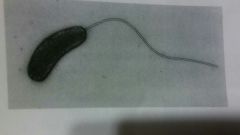
Monotrichous |
Single flagellum |
|
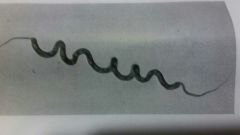
Amphitrichous |
Single flagellum at each end. |
|

Lophotrichous |
Tufts of flagella at one pole of cell |
|
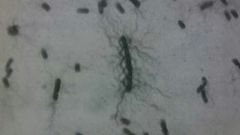
Peritrichous |
Flagella occur over the entire cell surface |
|
|
Three basic parts of flagellum |
Filament Hook Basal body |
|
|
Filament |
Outermost part Has a constant diameter Is composed of a single protein called flagellin that is repeated many times. Arranged in a chain that is intertwined and forms a helix around a hollow core. Attaches to a larger protein called a hook. |
|
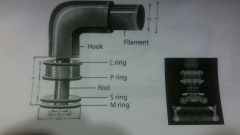
Basal body |
the motor & the anchor of the flagellum Attaches flagellum to the cell wall in the cytoplasmic membrane It is composed of a central rod which is inserted into a series of rings |
|
|
Gram-negative bacteria |
Have 4 rings. The outer pair is anchored to the cell wall and the inner pair to the cytoplasmic membrane Contain fewer layers of peptidoglycan. |
|
|
Gram positive cells |
Have 2 rings anchored to the cytoplasmic membrane Have many layers of peptidoglycan which form a very thick, rigid cell wall |
|
|
Gram staining |
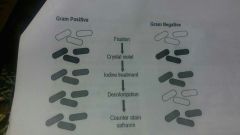
|
|
|
Runs |
When flagella bundles up and pushes cell along in One Direction |
|
|
Tumbles |
Reversing the direction of a run Causes the bundle to fly apart |
|
|
Taxis |
A process by which bacteria move toward or away from a particular stimulus
Chemical stimuli result in chemotaxis Light stimuli cause phototaxis |
|
|
Positive stimulant or attractant |
Cell undergoes more runs toward that attractant |
|
|
Negative stimulus or repellent |
Causes bacterium to spend more of its time tumbling |
|
|
Two other forms of flagellar motility |
Corkscrew (axial filaments); Gliding (rare) |
|
|
Spirochetes |
Ex. Treponema pallidum ( syphilis) Borrelia burgdorferi ( Lyme disease) Have axial filaments |
|
|
Axial filaments |
Bundles of fibrils or Endoflagella Come from the end of a cell beneath the outer sheath (membrane) (membrane) spiral around the cell. Rotation of them causes bacteria to Corkscrew through the medium |
|
|
Gliding |
Form of bacterial motility that is not common. It occurs when a cell attached to a surface oozes along that surface. Similar to amoeboid motility in eukaryotes. |
|
|
Prokaryotic motility vs. Eukaryotic motility |

|
|
|
Fimbriae |
Hairlike appendages which are shorter straighter and thinner than flagella. Usually used for attachment rather than motility. Occur at the poles of the cells or distributed over the surface. |
|
|
(Sex) Pili |
Are made of a single protein called pilin , which is arranged helically around a central core. Allows the cell to adhere to surfaces and contribute to virulence of organisms i.e. Neisseria gonorrhoeae
Are usually longer than fimbriae with only about 1 to 10 per cell.
Function is to join bacterial cells during transfer of genetic material or conjugation. |
|
|
The prokaryotic cell wall |
A complex semi-rigid structure structure which provides shape and main function is to prevent cell lysis during increased osmotic pressure. Also medically important in aiding in the ability of the bacterium to cause disease but also a target for antibiotics and chemicals (although many antibiotics do notb target bacterial cell wall.) Composed of a network of molecules called peptidoglycan. |
|
|
Peptidoglycan |
A mucopolysaccharide composed composed of repeating disaccharides attach to chains of 4-5 amino acids called peptide crossbridges |
|
|
The disaccharide of the peptidoglycan |
Is composed of Two Sugars related to glucose called: n-acetylglucosamine acid (NAG) & n-acetylmuramic acid (NAM)Rows Rows Rows of this dresssaccharide linked together to form what is called carbohydrate backbone |
|
|
The Lattice pattern of peptidoglycan |
Formed by parallel rows that are linked by short connecting chains of amino acids |
|
|
Tetrapeptide cross-bridges |
Consisting of different isomers of four amino acids, these cross-bridges join the layers of peptidoglycan sheets. |
|
|
All YOUR proteins are made of L- isomers of amino acids. It is a unique feature of BACTERIA that... |
They have D- amino acid isomers in their tetrapeptides. |
|
|
Teichoic Acids |
Only found in gram-positive cell walls, Each of which is composed of an alcohol and a phosphate group - are negatively charged and may control the movement of positively charged particles into and out of the cell - also control the action of autolysins, which are enzymes required to cause breaks in the cell wall during the addition of new cell components required for elongation and binary fission - may also be a source of phosphate - are strong antigens and targets of serological assays used to identify bugs. Lipoteichoic acids span the peptidoglycan of and are anchored into the cytoplasmic membrane Wall teichoic acids are linked only to the peptidoglycan layer itself |
|
|
UNIQUE GRAM POSITIVE GENERA Several medically important streptococci are covered with... |
Phospholipid layers which make them distinct |
|
|
Cell walls of mycobacteria contain the waxy lipid compound called... |
Mycolic acid In terms of staining this genus simple stains and gram stains cannot be used. Carbolfuchsin ( which contains fuchsin dye and carbolic acid) along with heat is enough to penetrate the waxy lipid cell wall. This is known as the acid fast staining technique |
|
|
Gram-negative cell walls |
Have very few layers of peptidoglycan and an outer membrane Peptidoglycan is bonded to lipoproteins in the outer membrane |
|
|
The periplasmic gel |
Lies between the peptidoglycan and the outer membrane. It contains a number of enzymes and transports proteins. |
|
|
Gram-negative outer membrane |
Has a strong negative charge and plays an important role in invasion of the host immune system The membrane is semipermeable in order to take up nutrients that are needed It is also a barrier two antibiotics such as penicillin, lysosome, detergents, heavy metals, bile salts, digestive enzymes and dyes. |
|
|
The gram-negative outer membrane contains... |
LPS (lipopolysaccharide) Lipoproteins Phospholipids |
|
|
LPS |
Provides 2 important functions 1. O polysaccharide which is composed of sugars that function as a strong antigen 2. Lipid A (endotoxin) It is b/c of this part, that antibiotics targeting gram-negative bacteria can inadvertently cause more damage upon treatment as a result of cell lysis and the release of lipid a. This toxicity in humans can cause fever, vasodilation, inflammation, blood-clotting and shock. |
|
|
Lipoproteins |
Proteins which are covalently linked to lipids and are responsible for linkage of the peptide of glycan to the outer membrane (OM). |
|
|
PORINS |
Alone non-specific passage of small molecules. |
|
|
Specific channel proteins |
Also allow the passage of compounds such as vitamins, iron nucleotides, and some sugars. May also be targets for attachment of bacteriophages or bacteriocins |
|
|
Bacteriocins |
Proteins produced by competing bacteria which inhibit or kills susceptible strains. |
|
|
Unique gram-negative genus There are gram-negative species which have different characteristics |
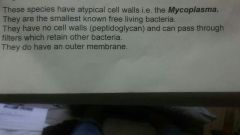
Also cell membranes contain lipids called sterols which may serve a protective function |
|
|
The archaea cell walls |
Are composed of polysaccharides and proteins but NO peptidoglycan |
|
|
Chemicals that Target bacterial peptidoglycan |
Lysozyme Is an enzyme which is naturally found in human cells in tears mucus and saliva. In Acts well against gram-positive cell walls by hydrolyzing bonds between sugars and the polysaccharide backbone. This usually results in osmotic lysis |
|
|
Protoplast |
When the gram positive cell walls degraded but the cytoplasmic membrane remains intact |
|
|
Spheroplast |
When lysozyme is applied to gram-negative cell walls the entire cell wall is usually not destroyed because of the protective OM. This forms a Spheroplast |
|
|
Spheroplast and protoplast are very susceptible to.... |
Osmotic lysis |
|
|
If gram-negative cells are first treated with__________which weakens the bonds of the outer membrane, lysozyme is more effective |
EDTA |
|
|
NOTE TO SELF**** |
All antibiotics do not target peptidoglycan. Penicillin is simply one example of one that does. Many target bacterial membranes & some target bacterial metabolism and others top of ribosomes ,etc |
|
|
The cytoplasmic membrane |
Consists of mostly of phospholipids and proteins. Eukaryotic membranes also contain carbohydrates and steroids such as cholesterol. Cholesterol provides rigidity to the cell membrane of eukaryotic cells which lack rigid cell walls. |
|
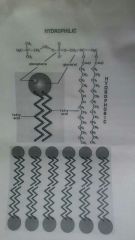
Phospholipid molecule has... |
OUTWARD IN BILAYER Hydrophilic and Polar head composed of a phosphate group and glycerol
INWARD IN BILAYER Hydrophobic Nonpolar tails composed of fatty acids |
|
|
Peripheral proteins |
Lie at the outer or inner surface of the membrane |
|
|
Integral membrane proteins |
Other proteins which can only be removed by disrupting the bilayer with something like a detergent. Some May function as channels through the bilayer so that materials can pass into or out of the cell. |
|
|
Chemical agents that destroy the CM |
-Alcohols -Quaternary ammonia compounds . (which are used in disinfectants) -polymyxins antibiotics that disrupt the cellular membrane causing leakage and death |
|
|
Enzymes involved in photosynthesis that are found in foldings of the CM which extend into the cytoplasm are called... |
Chromatophores or thylakoids |
|
|
Materials move across cm by what two processes? |
Passive and active transport |
|
|
Passive transport
Simple diffusion Osmosis Facilitated diffusion |
When a substance moves from a region of high concentration to an area of low concentration without the extra denture of ATP AGAIN THESE 3 PASSiVE TRANSPORT MECHANISMS DO NOT USE ATP |
|
|
Simple diffusion |
The net movement of molecules or charged atoms |
|
|
Facilitated diffusion |
Occurs when a substance such as glucose combines with a carrier protein in the CM. (permeases) The permease remains in the CM BUT CHANGES SHAPE and allow molecule to pass. |
|
|
VERY IMPORTANT |
Facilitated diffusion does not involve the use of ATP |
|
|
Osmosis |
The net movement of solvent usually water through a selectively permeable membrane into an area where solvent molecules are at a low concentration |
|
|
Osmotic pressure |
The pressure needed to stop the flow of water across a selectively permeable membrane |
|
|
Equilibrium |
When water molecules enter and leave a membrane at the same rate |
|
|
Isotonic solution |
Solution in which overall concentration of particles or solids are the same on both sides of the membrane |
|
|
Isotonic solution |
Solution in which overall concentration of particles or solids are the same on both sides of the membrane |
|
|
Hypotonic solution |
When there's a higher concentration of particles inside the cell compared to outside the cell |
|
|
Hypertonic solution |
A medium having a higher concentration of solutes outside of the cell |
|
|
Plasmolyze |
When so cytoplasm will shrink and collapse |
|
|
Plasmolyzed cells |
Are metabolically inactive |
|
|
ACTIVE MECHANISM
EX. ACTIVE TRANSPORT GROUP TRANSLOCATION( in prokaryotes only) |
Process involves energy used in the form of ATP to move substances from area of low concentration to area of high concentration that is they are moving against the concentration gradient. This mechanism is especially important when nutrient concentrations are low. |
|
|
IMPORTANT NOTE!!! |
Active transport mechanisms like phagocytosis or endocytosis or exocytosis do not occur in bacteria |
|
|
CYTOPLASM |
The internal Matrix of the cell located within the cytoplasmic membrane.
Cytosol is the liquid portion of the cytoplasm and is 80% water. It also contains proteins or enzymes carbs and lipids inorganic molecules and other very small compunds.
It is thick aqueous semi-transparent inelastic and it contains DNA ribosomes and inclusions. |
|
|
Prokaryote's genetic material |
Consists of a single circular molecule of double stranded DNA cold the bacterial chromosome Bacterial DNA is not with histones and not surrounded by a nuclear membrane it's located in the region called the nucleoid DNA accounts for about 20% of the sales volume chromosome is attached to the CM In addition to the chromosome bacterial cells also contain plasmids small circular pieces of double-stranded DNA which replicate independently of the chromosome |
|
|
PLASMIDS |
plasmids can be usually gained or lost without harming the cell they often and code toxins and other virulence factors and antibiotic resistance plasma can be transferred from one bacterium to another and are used frequently in biotechnology |
|
|
INCLUSIONS |
Found in both prokaryotic and eukaryotic cells 1. Metachromatic granules serves as a reserve for phosphate to be used during ATP synthesis these are very common in the bacterium corynebacterium diphtheriae which causes diphtheria 2. Polysaccharide granules consisting of glycogen and starch 3. Lipid inclusions after composing a molecule unique to bacteria called poly beta hydroxybutyric acid which can be stained by lipid dyes 4. Sulfur inclusions 5. Carboxysomes which are conclusions that contain enzyme ribulose 1, 5 - diphosphate carboxy carboxylase which is used to convert CO2 to Sugar during photosynthesis 6. GAS VACUOLES. Friend in mini aquatic prokaryotes. They're composed of row of gas vesicles which are Hollow cylinders covered with protein. These are used for buoyancy to keep the bacteria and a certain depth. |
|
|
Each ribosome is composed of... |
Two protein subunits and molecules of RNA called ribosomal RNA or rRNA |
|
|
70s ribosomes |
prokaryotic ribosomes |
|
|
80s ribosomes |
Eukaryotic ribosomes |
|
|
Svedberg units |
The s in 70s and 80s ribosomes it indicates the relative unit of sedimentation during high-speed centrifugation |
|
|
The subunits of the 70s ribosome include |
30s subunit with one molecule of rRNA & 50s subunit with two molecules of rRNA |
|
|
ANTIBIOTICS THAT KILL BACTERIA BY shutting down protein synthesis |
Streptomycin Neomycin TetracyclinesThey They are specific for the 50th subunit of prokaryotic ribosomes and then therefore safe for the use of eukaryotic organisms |
|
|
Evidence that eukaryotes may have evolved from prokaryotic cells |
Organelles within eukaryotic cells such as mitochondria and chloroplasts contain 70s ribosomes as do bacteria in addition these organisms divide by binary fission and contain DNA RNA and enzymes on their own |
|
|
Prokaryotic sporulation |
When oxygen is depleted in water isn't available many bacterial species such as clostridium and bacillus species form dormant structures called endospores little highly stable dehydrated cells within thick walls and other additional layers |
|
|
Usually endospores are only formed by gram-positive organisms but there's one exception a gram-negative organism called... |
Coxiella burnetii which causes Q fever |
|
|
SPORULATION |
NOTE that this is NOT a form of reproduction.b/c a single spore becomes a single new vegitative cell. Process by which endospores are formed by vegetative parent cells |
|
|
Dipicolinic acid acts as a... |
DNA PRESERVATIVE |
|
|
GERMINATION |
Process by which endospores return to their vegetative state. |

